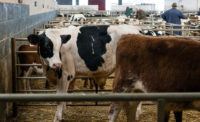The University of Wisconsin-River Falls Animal Welfare Lab’s summary of the USDA’s Food Safety and Inspection Service’s (FSIS) humane handling regulatory activity from 2018 identified ineffective stunning as the most common cause of suspension, notice of intended enforcement (NOIE) and suspension reinstatement for violations of the Humane Slaughter Act and 9 CFR 313.
In total, 89 of 109 regulatory actions (81.7 percent) cited stunning-related issues as their cause. Previous surveys from 2016 and 2017 reported similar results supporting the idea that additional attention to stunning efficacy is necessary. It is important to note that ineffective stunning is not an issue in all slaughter establishments — it appears to depend heavily on the amount of focused attention and commitment to “getting it right” that management and stunning personnel have invested at each facility. Within the 89 stunning-related enforcement actions in 2018, 75 (84.3 percent) were linked to ineffective mechanical stunning. Specifically, mechanical stunning included gunshot and captive bolt. Only half of the enforcement action letters clearly identified the reason for the stunning issue that triggered the regulatory action. Within the letters that cited a reason, more than half (26 of 44, or 59 percent) were because of improper shot placement. The key ingredients to accurate stun placement include effective training, equipment that matches the ergonomic needs of the operator and predictable head location at the time of stunning. The encouraging news here is that all of these can be optimized with attention, creativity and careful adjustment. As in any other sector or phase of food production, we don’t have to accept the current challenges as permanent roadblocks.
State of the Industry 2019
OverviewBeef (NCBA)
Pork
Chicken
Food Safety
Packaging
Beef (CAB)
Turkey
Veal
Lamb
Animal Welfare
Seafood
Workforce
Watch the 2019 State of the Industry Webinar
Register for free today!
Scientific validation needed
In recent years, new scientific studies have focused on the validation of mechanical stunning parameters that were historically developed through practical experience in the field. As an example, work at Colorado State University has taken a closer look at the profile of brain trauma from differing bolt lengths in the same pneumatic captive-bolt stunner. A couple of interesting conclusions that may be contrary to long-held industry beliefs were reported. First, it has been commonly assumed that the longer bolt that was used in their study would cause damage to the brain stem, a region of the brain that supports basic body functions necessary for life, such as breathing and controlled beating of the heart. Their study found that none of the three bolt lengths they tested could reach the brain stem when used in commercial conditions (at the restrainer in a commercial slaughter facility instead of on the bench in a laboratory). Second, they found the length of the bolt didn’t have an impact on the detection of an indicator protein of specified risk material (SRM) leakage into the bloodstream. A common reason that some plant management personnel were concerned with using longer bolts was the potential for SRM contamination within the carcass. Interestingly, the authors of the study explained that splitting saws contribute a more consistent and greater quantity of SRM contamination to beef carcasses.
Always keep searching
As we round out 2019, take the time to reflect on the commonly held beliefs that might need a closer look. Sometimes that requires asking whether there is hard evidence to support the decisions we are making. It is within our nature to become uncomfortable when we start to question thoughts that were just accepted as true. Fortunately, it’s also in our nature to search for answers. NP







Report Abusive Comment